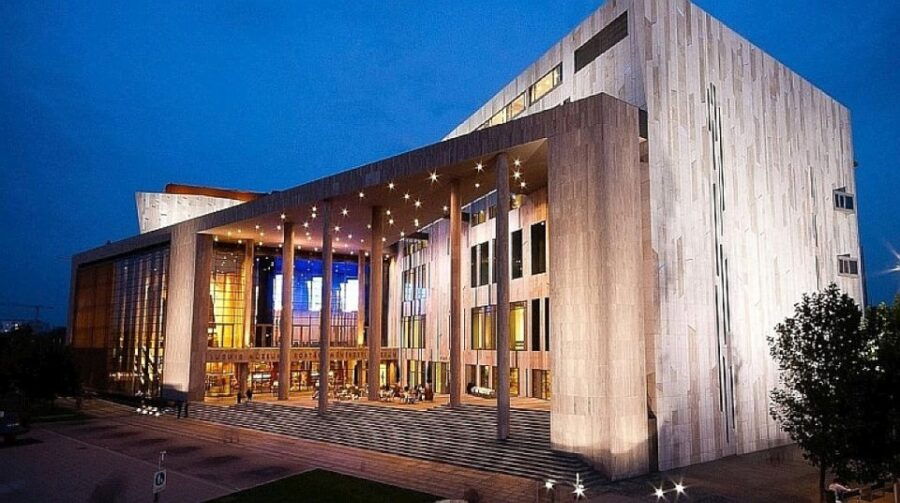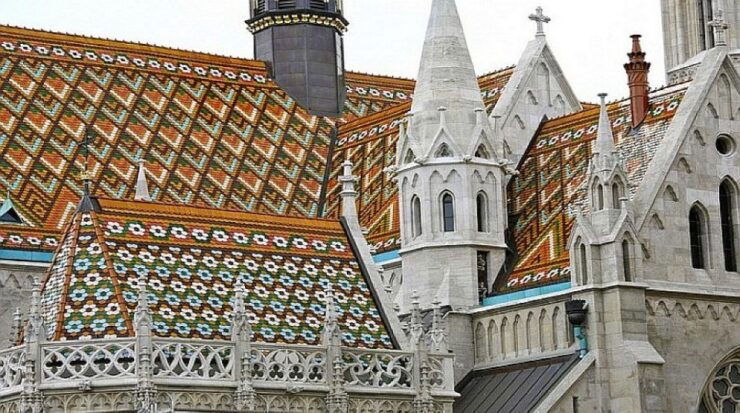Set out on a journey through the intricate tapestry of Budapest’s architectural gems, each structure a unique chapter in the city’s storied history. From the symphonic elegance of the Music Academy to the majestic allure of St. Stephen Basilica, these buildings stand as testaments to the city’s cultural richness.
As the layers of Baroque, Neo-Gothic, Neo-Renaissance, and other styles unfold, a captivating narrative emerges, inviting exploration into the depths of each architectural marvel. But there’s more to uncover beyond the surface; a world of architectural wonders awaits those who seek to unravel Budapest’s hidden treasures.
Good To Know

- Budapest’s architectural gems span centuries and styles, reflecting a rich cultural history.
- From Gothic splendor to Baroque elegance, each building tells a unique story of the city.
- Artistic influences like Art Nouveau and modern designs add a vibrant touch to Budapest’s skyline.
- Explore architectural wonders like St. Stephen Basilica and Vajdahunyad Castle for a profound cultural experience.
Music Academy and St. Stephen Basilica

Nestled in the heart of Budapest are the captivating Music Academy and the awe-inspiring St. Stephen Basilica, showcasing a harmonious blend of architectural beauty and historical significance.
The Music Academy, a magical place where Apollo and Dionysus whisper, stands as a testament to Hungary’s rich musical influences. Its walls echo with the melodies of past students who’ve gone on to shape the world of music.
On the other hand, the St. Stephen Basilica houses the mummified right hand of the first king, highlighting its deep-rooted historical significance.
Both structures not only offer architectural marvels but also serve as windows into Budapest’s cultural and artistic heritage, making them must-visit destinations for those seeking a profound experience in the city.
Find more activities and experiences we've covered in Budapest.
Vajdahunyad Castle Architectural Styles
Admire the Vajdahunyad Castle’s remarkable architectural diversity, which showcases a captivating fusion of styles spanning centuries. This castle stands as a testament to the historical evolution of architecture, blending various influences to create a truly unique masterpiece.
The architectural fusion seen in Vajdahunyad Castle incorporates elements from different periods, including Baroque, Romanesque, Gothic, and Renaissance styles, offering visitors a visual journey through time. Each section of the castle represents a different era, highlighting the rich tapestry of architectural history present in Budapest.
From the intricate details of the Neo-Gothic to the grandeur of the Neo-Renaissance, Vajdahunyad Castle is a treasure trove of architectural wonders waiting to be explored.
Budapest’s European Architecture History
Budapest’s European architecture history unfolds like a vibrant tapestry, weaving together centuries of diverse styles and influences that have shaped the city’s iconic skyline. The architectural evolution of Budapest is a testament to its rich historical influences, reflecting a blend of Roman, Gothic, Ottoman, and Baroque elements. From the medieval Buda Castle to the elegant Chain Bridge, each structure tells a story of the city’s past. The eclectic mix of architectural styles, including Neo-Gothic, Art Nouveau, and Neo-Classical, showcases Budapest’s resilience and adaptability through the ages. Visitors can explore the interiors of remarkable buildings like the Hungarian Parliament and Gellért Thermal Bath, seeing the grandeur and beauty of Budapest’s architectural heritage.
| Architectural Styles | Historical Influences | Notable Buildings |
|---|---|---|
| Roman | Gothic | Buda Castle |
| Ottoman | Baroque | Chain Bridge |
| Neo-Gothic | Art Nouveau | Hungarian Parliament |
Baroque, Neo-Gothic, Neo-Renaissance Buildings
Exploring the streets of Budapest reveals a breathtaking array of Baroque, Neo-Gothic, and Neo-Renaissance buildings that stand as majestic testaments to the city’s architectural prowess.
The Baroque revival movement in architecture is evident in structures like the stunning Hungarian National Museum, characterized by its ornate decoration and grandeur.
On the other hand, the Neo-Gothic revival style, seen in landmarks such as the majestic Matthias Church, boasts pointed arches and intricate tracery, evoking a sense of Gothic splendor.
Neo-Renaissance buildings like the iconic Hungarian State Opera House showcase elaborate facades, classical motifs, and a return to symmetry and proportion reminiscent of the Renaissance period.
These architectural marvels not only enrich Budapest’s skyline but also offer a glimpse into the city’s rich historical and artistic heritage.
More Great Thing To Do NearbyArt Nouveau and Post-Modern Structures
The architectural journey through Budapest transcends time and styles, now shifting focus to the enchanting Art Nouveau and Post-Modern structures that grace the cityscape. Art Nouveau buildings in Budapest, influenced by nature and curved lines, offer a glimpse into the artistic influences of the early 20th century. Contemporary interpretations of Art Nouveau elements can be seen in the intricate facades and decorative motifs of buildings like the Gresham Palace and the Museum of Applied Arts. On the other hand, Post-Modern structures blend traditional architectural forms with modern design elements, creating a harmonious contrast in the urban landscape. Budapest’s Post-Modern buildings, such as the Budapest University of Technology and Economics, showcase innovative approaches to architecture, emphasizing creativity and individuality.
| Art Nouveau Structures | Post-Modern Structures |
|---|---|
| Gresham Palace | Budapest University of Technology and Economics |
| Museum of Applied Arts | Contemporary Art Museum Budapest |
| Bedő House | Palace of Arts |
| Király Street | Hungarian National Theatre |
| Hungarian State Opera House | Hungarian National Bank |
Special Itineraries for Architectural Exploration
For those seeking a unique architectural adventure, explore custom itineraries that unveil hidden gems and remarkable structures in Budapest. Exploration routes crafted specially for architectural enthusiasts offer a chance to discover the intricate architectural details of Baroque, Neo-Gothic, Neo-Renaissance, Neo-Classical, Art Nouveau, and Post-Modern buildings scattered throughout the city.
These special itineraries provide a curated experience, guiding visitors through lesser-known architectural wonders and highlighting the unique characteristics of each structure. From the grand facades of historical landmarks to the hidden gems tucked away in bustling neighborhoods, these custom routes offer a comprehensive look at Budapest’s diverse architectural landscape.
Enjoy the captivating world of architecture with these specialized itineraries tailored to showcase the city’s architectural treasures.
Common Questions
Are There Any Restrictions or Requirements for Visitors Who Want to Explore the Interiors of Buildings Like the Bedő House and Parliament in Budapest?
Visitor restrictions and interior requirements for exploring sites like the Bedő House and Parliament in Budapest vary. Some locations may have limited access, require guided tours, or specific permits. It’s advisable to check individual restrictions before planning your visit.
Can Visitors Expect to See Any Special Exhibits or Performances at the Music Academy During the Guided Tour?
Visitors on the guided tour of the Music Academy can expect to encounter special exhibits and live performances that showcase the institution’s rich cultural heritage. These experiences add depth and vibrancy to the tour.
Is There a Specific Time of Day When the Architecture of Vajdahunyad Castle Is Especially Striking or Photogenic?
During the golden hour or morning light, Vajdahunyad Castle’s architectural beauty shines, making it a stunning spot for sunset photography. The play of light and shadows accentuates the intricate designs, creating a mesmerizing sight for visitors.
Are There Any Lesser-Known Architectural Gems in Budapest That Are Not Included in the Standard Tour Itinerary?
There are hidden gems and off the beaten path architectural secrets in Budapest that locals love. These lesser-known treasures offer a unique perspective on the city’s diverse architectural landscape, adding depth to any exploration.
How Does Budapest’s Architecture Reflect the City’s Historical and Cultural Influences Over the Past Thousand Years?
Budapest’s architectural evolution over a millennium reflects its rich historical and cultural influences. From Baroque to Post-Modern styles, the city’s buildings narrate a captivating tale of resilience, innovation, and the fusion of diverse artistic traditions.
The Sum Up
Set out on a journey through Budapest’s architectural wonders with a private guided tour that unveils centuries of history and diverse styles. From the enchanting Music Academy to the grand St. Stephen Basilica, each building tells a unique story of European heritage.
Explore the intricate blend of Baroque, Neo-Gothic, Neo-Renaissance, Neo-Classical, Art Nouveau, and Post-Modern structures that adorn the cityscape. Let the captivating beauty of Budapest’s architectural gems leave you in awe and inspired for more discoveries.
You can check if your dates are available here:More Tour Reviews in Budapest
Looking for something different? Other Budapest activities we've written about
- Visegrád Hike & Castle Tour with Ferry from Budapest
- Walk along the Champs-Élysées in Budapest
- Wine taste in Tokaj Private Day Tour from Budapest
- Winetaste in Villany, sightseeing in Pécs, private tour
- Winetaste in Szentendre Private Hafday private Tour
- Your Own Budapest: Jewish District Walking Tour
- Budapest walking tour: Parliament and Shoes Memorial
- Budapest Essential Walking Tour&Traditional Hungarian Dessert
- PRIVATE Budapest Jewish Heritage Walking Tour – Food Tasting
- Godollo Royal Palace Full-Day Tour from Budapest
- Budapest: Virtual Reality Tour in 8 Languages
- Budapest: Stretched Strudel Making Class with 2 Fillings
